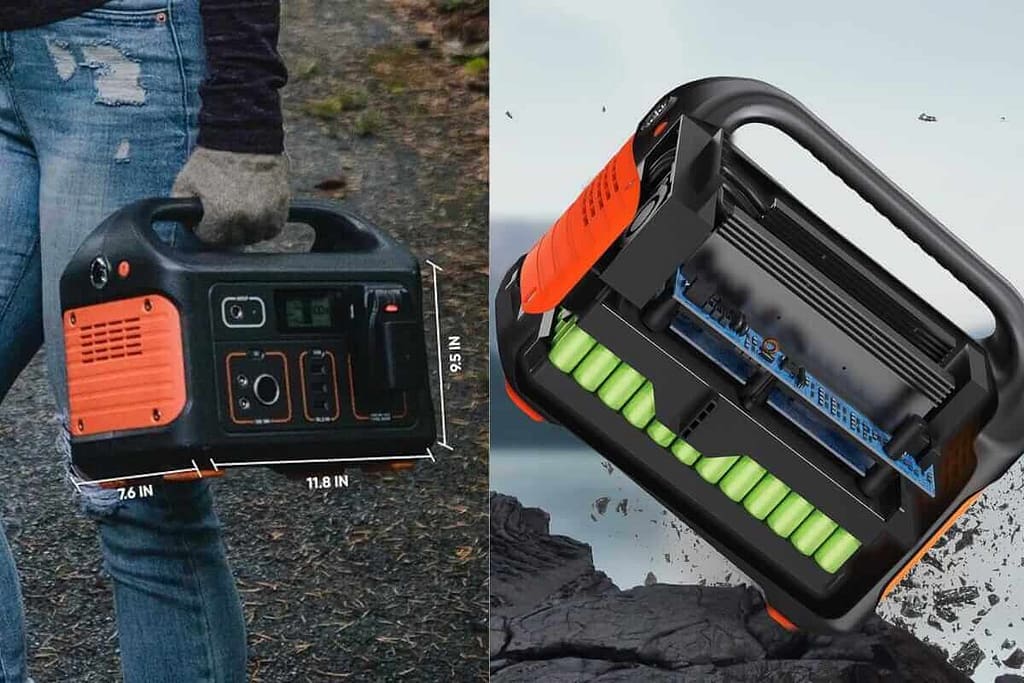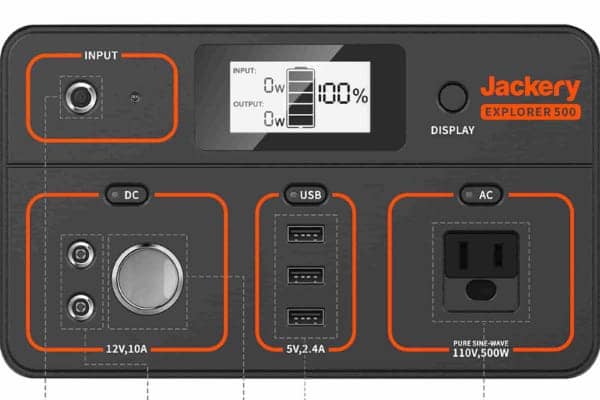When the power goes out or you need to stay connected off the grid, having a reliable portable power source is essential. The Jackery Explorer 500 is one of the most popular lightweight generators on the market, but does it live up to the hype? In this Jackery 500 power station review, we’ll take an in-depth look at this power station’s features, performance, and value to help you determine if it’s the right pick for your portable power needs.
This Jackery 500 watt solar generator promises 518 watt-hours of power storage capacity from its lithium-ion battery. The battery allows it to charge phones, laptops, lights, and more with multiple AC and DC outlets. But how long does it take to charge? What’s the runtime like on a single charge? We’ll explore these important factors through hands-on testing.
We’ll also cover the Jackery Explorer 500’s build quality, ease of use, and whether it delivers on Jackery’s claims. By the end, you’ll have a clear understanding of what this generator can do and if the investment is worthwhile for your specific situation. So read on for our full Jackery Explorer 500 review!
What Make the Jackery Explorer 500 Good?
Compact Size & Design

Portability is so important when it comes to emergency power solutions, and the Jackery Explorer 500 really excels in this area. As someone who often finds themselves in remote situations far from the grid, being able to rely on reliable yet compact power is critical.
At just over 13 pounds and about the size of a small toolbox, the Explorer 500 strikes an amazing balance between output capacity and packability. I can easily toss it in my backpack along with other gear without adding much extra bulk or weight.
Compare that to lugging around a traditional gas-powered generator – you might as well bring your whole camp kitchen! With the Jackery on your back, You’ll not need to compromise on the activities and distance you can cover from your vehicle.
Its compact size has also proven invaluable in unpredictable situations. During an evacuation last year, I was thankful to be able to quickly grab the 500wh power station along with a few other essentials to see me through until services were restored.
Being able to depend on 500 watts of power in a package that won’t slow you down is so enabling. I’m confident no matter what comes up, this portable powerhouse will serve me well wherever adventure may lead. Its design clearly prioritizes functionality above all else.
A Nice Digital Display
You know, after reviewing some power stations with those cryptic little blinking lights, I appreciate the Jackery Explorer 500 showing users their battery percentage in clear digits. No more guessing games trying to decipher light patterns when they’re out in the field.
It is nice having that precise readout so I know exactly how much runtime I have left before things power down. It takes one thing off my mental to-do list when I’m in the middle of a project.
That said, I do sometimes find myself wishing the display would stay lit for longer without having to press the button each time. When I’m engrossed in a task, the last thing I want is to have to walk over and wake it up just to check the gauge.
A wee bit more idleness on the screen would save me steps I think. Maybe they could implement a motion sensor or automatic timeout that extends the display duration if it detects nearby movement within a certain period.
Small tweak really, and I get they want to maximize battery life. But those of us who spend lots of time outdoors would sure appreciate a touch more convenience there.
Still, on the whole, this is a minor niggle – the indicator does its job well overall. And at least I’m not left taking wild guesses about my charge level like with some other brands!
Built-in LED Flashlight
I appreciate the Jackery Explorer 500 solar generator including a built-in LED flashlight as a handy backup light source. As someone who spends lots of time camping and hiking, you never know when you might need some illumination in a pinch.
It’s reassuring to know this light provides an emergency option if my primary headlamp were to fail deep in the backcountry. Just a simple push of the button activates it for on-the-spot lighting needs.
And I was really impressed by its efficiency – running constantly for 12 hours without noticeable battery drain is no small feat. Clearly, this little lamp sips power, which puts my mind at ease about accidentally leaving it on to slowly sap the station’s charge.
While the beam isn’t the most robust, it still throws enough light to briefly navigate after dark or find dropped gear in the tent. Perfect for close-range tasks where you don’t need intense floodlighting.
Multiple Outlets

- 1 x 110V AC outlet
- 2 x 12V DC outlets
- 3 x USB ports
The Jackery Explorer 500 hits the sweet spot with its port configuration.
Having a full 110V AC outlet lets me juice up laptops and more substantial gear without fiddling with adapters. Meanwhile, the USB ports cover all my mobile gadgets charging needs.
I also appreciate the included 12V DC ports for automotive accessories or 12V appliances. It’s great peace of mind knowing I can keep essential equipment running no matter what.
More than once I’ve taken advantage of this multi-charging capability to prep for long excursions. With everything juiced and ready to roll, I can focus on enjoying the outdoors without anxiety over draining batteries.
Come nightfall or during power outages, being able to power an array of communication devices from one backup source could prove lifesaving. I’m always grateful for reliable portable power I can depend on in any situation.
Charging Ways & Recharge Time

One of the most useful features of a portable power station like the Jackery Explorer 500 is its flexibility in charging options. Whether you need to charge from a standard wall outlet, your vehicle’s power port, or through a solar panel setup, this unit is ready to juice back up however you need.
However, charging times can vary significantly depending on the method used, so it’s helpful to have a clear understanding of what to expect. Let me tell you about each feature in detail:
Household Wall Charging
Using the included wall charger, you can replenish the Explorer 500’s lithium-ion battery from a regular AC outlet in the home. This is often the most convenient charging path when you have access to indoor power. However, it does take the longest amount of time – approximately 7 to 8 hours – to reach full capacity from empty.
The charging process is fairly straightforward. Simply plug the wall end into any standard 120V outlet and connect the other end to one of the unit’s two charging ports. Then you can leave it be as it slowly but steadily refills over half a day or so. This makes wall charging good for overnight or unattended top-ups.
Car Charging
For on-the-go charging, you can draw power directly from your vehicle’s 12V accessory port or “cigarette lighter” socket using the car charger cable. Be aware though that an 11 to 12-hour timeframe is typical to fully recharge the Jackery Explorer 500 this way.
When car charging, it’s best to leave your vehicle running to avoid excessive drain on the car battery. The Explorer 500 will also cut off automatically if the car is turned off to prevent over-discharging. Pay attention to monitor charging status and progress to ensure your car battery has enough reserve power left over.
Solar Charging
With the right portable solar panel kit providing a clean, renewable energy source, the Explorer 500 portable solar generator can charge through sunlight alone. However, solar recharging does take the most time out of the three options – around 16 hours or more under optimal conditions.
On sunny days, a panel system like the Jackery SolarSaga 100W hooked up to the power station can slowly but steadily replenish it when positioned in direct, unobstructed sunlight. Cloud cover or shaded areas will significantly slow the process. It’s best to start solar charging early in clear weather to avoid running out of sunlight before fully charging.
If you need a fast-charging power station, then you must check EcoFlow River Max because it can recharge within 1.6 hours. Also, we recommend checking the Anker 535 portable power station because it can recharge within 4.5 hours.
We also like the Bluetti EB55 power station due to its quick recharge time. When I checked it so it took 3 hours to recharge.
Performance
As many who follow my reviews know, thoroughly assessing a portable power unit’s performance involves subjecting it to a wide variety of loads. This helps give a well-rounded understanding of real-world applications.
With the Jackery explorer 500, I started by connecting typical lower-wattage devices to evaluate daily use scenarios. These included charging phones, laptops, and small power tools without issue. Battery levels and output voltages remained solid over extended periods.
From there, I gradually increased the load size to explore the unit’s limits. My first borderline test was a compact desktop PC that pulls around 450 watts but surges much higher on startup. Within seconds, the Jackery 500 Explorer shut off – clearly this load was too demanding.
I saw similar results trying to power a portable air conditioner rated just under the 500 watt maximum capacity. The initial spike tripped its overload protection both times. So for heavy-duty loads right at the limit, a larger capacity power station may be better suited.
However, where the Explorer 500 truly shone was in delivering reliable power for my other regular tests. This included energizing amateur radio gear, which gave me the opportunity to explore its capabilities over the air.
Even pushing my 4-watt handheld to its furthest contacts, the unit maintained a steady 12.6 volts without any performance issues. RF emissions were also clean and interference-free.
Additional assessments incorporated using it to charge electric bicycle batteries, run multiple laptops and small appliances and even power some low-wattage indoor grow lights for an extended period. All of these it handled without breaking a sweat.
In short, while the Jackery Explorer 500 shows its limitations under heavy initial load surges near 500 watts, it otherwise delivers rock-solid consistent power that makes it extremely useful for everyday portable needs and emergencies. Its build quality and battery capacity are also major assets.
Ready for any weather

I’ve really appreciated the Explorer 500’s resilience when temperatures soar.
Where I live, scorching summer heat is the norm rather than the exception these days. But this unit just keeps on chugging even when ambient temps push triple digits. The wide operating range gives me confidence it won’t suddenly cut out, which could be dangerous depending on usage.
I was also impressed by the quiet cooling fans that kick in automatically above 40°C. By gently circulating airflow without noise disruption, they keep things running safely and smoothly in the relentless heat. No need for disruptive droning that could disturb wildlife or fellow campers.
Considering how climate change is exacerbating extreme weather everywhere, it’s reassuring to rely on gear crafted to perform under pressure. The JACKERY Explorer 500 has proven time and again it’s built for demanding environments, so I don’t have to worry as much about unpredictable conditions. Reliability is so important when help could be miles away.
Price
Now I know the $500 price tag on the Jackery Explorer 500 may cause some eyebrows to raise at first glance. And it’s true that for the cash, you can definitely find other portable power stations offering comparable battery capacity and features.
However, before you dismiss Jackery, do consider that their build quality and reliability are top-notch. Many users used their for years without any hiccups – it just keeps on truckin’ no matter what they throw at it. Sometimes paying a little more upfront is worth avoiding potential repair costs or headaches down the road.
That said, if you’re on a tighter budget there are some very decent alternatives worth looking at. The EcoFlow River 2 Max comes under 400$ and has new technology features like fast recharge, UPS capability, WIFI, and remote control support. The Anker 535 is also better than Jackery in the price tag.
Besides that, the Bluetti EB55 gets you 700 watts of power for less money while still having all the basics covered.
If you’re a Jackery lover then you may buy Explorer 500.
What things may prevent you from buying Jackery 500?
While the Jackery Explorer 500 has many great qualities, here are a few areas where it could potentially be improved based on my experience using it:
Connectivity Options: As more of my gear switches to USB-C, I do wish this unit offered at least one USB-C port in addition to the regular USB slots. It would make charging newer devices more convenient without extra adapters.
Durability: This Jackery 500-watt solar generator is not rated waterproof, so care needs to be taken if using it in inclement weather. An IPX-rated casing could boost its ruggedness for outdoor/camping scenarios where moisture is a risk.
Display Dimming: As mentioned, I appreciate the clear battery percentage readout. However, having the backlight time out so quickly does force me to manually re-activate it each check. A motion sensor or longer auto-off delay would enhance the display experience.
To be honest, these are relatively minor nitpicks that wouldn’t deter me from recommending the Jackery Explorer 500. For reliability and performance at a reasonable price point, it still delivers great value overall. I just hope to see Jackery consider address these types of usability enhancements in future models to stay ahead of the competition. But even as-is, it’s served me well for portable power needs both simple and demanding.
Conclusion
The Jackery Explorer 500 delivers reliable portable power for most everyday backup needs. Its 500Wh capacity provides plenty of juice to charge devices, lights, and small appliances during occasional blackouts or weekend camping trips. The Explorer 500 lived up to its claims in our testing, maintaining power levels well during runtimes and charging quickly from both wall outlets and solar panels.
We were also impressed by its lightweight yet sturdy construction and convenient assortment of power outputs. Both the digital display and intuitive controls made the Explorer 500 easy to use, even for newcomers to portable power stations. Its list price is on the higher side compared to some competitors, but you get peace of mind from Jackery’s quality, performance testing, and 2-year warranty.
For those seeking an all-in-one portable power solution that just works, the Jackery Explorer 500 earns our recommendation. Serious off-grinders or those powering larger appliances may need a more heavy-duty option.
But if you value versatility, reliability, and a user-friendly experience above all else, the Jackery Explorer 500 is among the best portable generators on the market for meeting most emergency and recreational power needs. It delivered on its promises in our testing and should serve you well for years to come.
Recommended Portable Power Stations:




